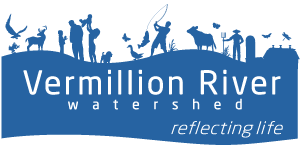Water Education Resources
The following educational resources can help you build environmental stewardship in the Vermillion River Watershed among all generations.
Display Checkout
We have interactive displays available for your classroom or community events. You can check out these educational tools for one week, free of charge, by emailing Brita Moore-Kutz or calling her at 952-891-7967 and arranging pickup. See below for options.
Video: Clean Streets Lead to Clean Waters
- Dakota County produced this video to provide a visual demonstration of storm sewer systems and illicit discharge. Helpful for all ages and for municipal separate storm sewer system (MS4) permit holders.
Watershed Game
- VRWJPO owns a copy of the Watershed Game, created by the University of Minnesota Sea Grant. The game is geared towards community leaders to simulate the decision-making process of protecting a local stream, with financial limitations built in. Contact Brita if you’re interested in using the game.
Project WET
- Project WET (Water Education for Today) is an international, interdisciplinary, water-science education program used by a variety of water users. It is estimated over 20,000 Minnesotans annually use the Project WET resources in a variety of ways, complementing other watershed programming. This hands-on program is administered through the Minnesota Department of Natural Resources (DNR) by the MN Project WET Coordinator. This award-winning curriculum is an exceptional resource for Minnesotans.
Virtual Meeting Backgrounds
Infographics
- Earth Friendly Landscaping
- Improving Water Quality
- Irrigation Efficiency
- Planting for Pollinators
- Smart Salting
Printable Activities for Kids
Metro Area Children’s Water Festival
- VRWJPO supports the Annual Metro Area Children’s Water Festival, an annual event produced for fourth graders in the Minneapolis-St. Paul metropolitan area. The festival teaches students about water resources and ways to protect them. Students visit hands-on learning stations staffed by environmental experts, attend the Science Museum of Minnesota presentation, and enjoy the Water Arcade. The festival is usually held the last Wednesday in September at the Minnesota State Fairgrounds. Teachers need to register for the opportunity to participate, though the virtual festival is free and available anytime. The Children’s Water Festival website contains the registration form, plus information on how to sponsor or volunteer.
More Options
- The U.S. Environmental Protection Agency has a dedicated Environmental Education section. Visit their website for lesson plans, grant opportunities, and more.
- The Hamline University Center for Global Environmental Education provides a series of digital lessons about stormwater stewardship and how our waterways connect to the seas. Whether for classroom or virtual learning, these can help kids find things they can do to protect water.
- Webinars on environmental education from the National Oceanic and Atmospheric Administration (NOAA) Planet Stewards
- CitizenScience.gov, a list of more than 200 citizen-science projects for students and adults, with a toolkit for people looking to design and maintain their own local projects
- Minnesota DNR resources


